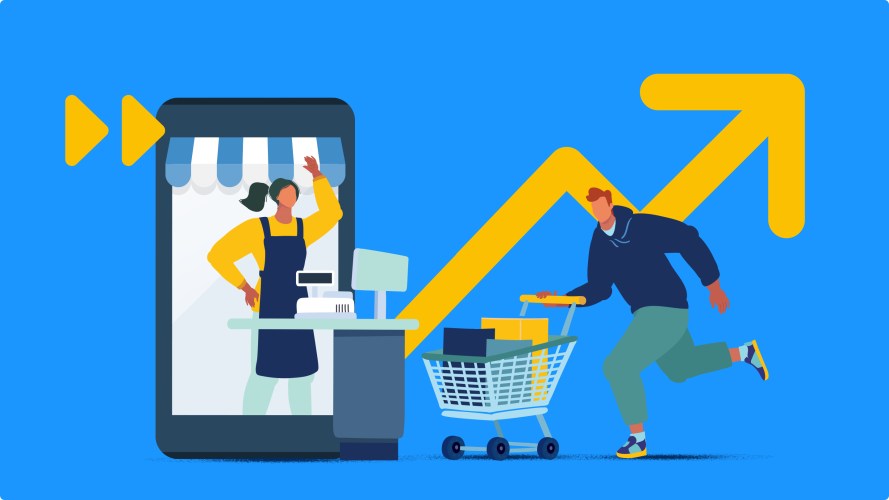Looking for your next best business strategy? Consider embracing a loss. Believe it or not, stepping into the red with a product can pull your profits into the green. This counterintuitive tactic — loss leader pricing — might be the move your business needs to expand your customer base and build lasting loyalty.
What you’ll learn:
- What is loss leader pricing?
- Benefits and pitfalls of using loss leaders
- Determining if loss leader pricing is right for your business
- How to implement a loss leader strategy
- Leveraging technology for loss leader pricing
Unify sales, finance, and legal on the #1 AI CRM
When sales, finance, and legal are disconnected, the customer feels the pain. Learn how Revenue Cloud can help.



What is loss leader pricing?
Loss leader pricing is when businesses sell a product or service at a loss to attract customers. The initial sacrifice in profit isn’t a sign of desperation, but an investment in future gains. A loss leader hinges on the expectation that while the specific item or service is sold below cost, it will lead customers to purchase other products or services that are priced to make a profit.
For example, a tech consultancy might offer a deeply discounted audit of a company’s IT systems. While the audit itself might not generate profit, it showcases the consultancy’s expertise and often leads to lucrative, full-service contracts.
Benefits and pitfalls of using loss leaders
Loss leader pricing is a delicate balance that can lure customers in with low prices and boost volume and market presence. However, there’s also the risk of financial losses and skewed customer expectations. Let’s take a closer look to ensure you use this strategy effectively and sustainably.
Loss leader benefits
- Attract new customers: Loss leaders can draw in customers who may not otherwise be aware of your brand. For example, a furniture store might offer a big discount on a popular couch model, which not only clears inventory but also increases foot traffic and leads to sales of other items at full prices.
- Increase sales volume: By offering loss leaders, businesses can expose customers to other products and services that may bring in higher margins. A bakery might sell loaves of bread at a loss, but the influx of customers could result in increased purchases of high-margin gourmet cheeses and preserves.
- Market penetration: Loss leader pricing can be especially effective when entering new markets or launching new products. For example, a startup beverage company might offer their new line of organic juices at a discount at local markets to rapidly gain customer interest and secure shelf space in regional grocery stores.
- Build customer loyalty: If customers have a positive experience with a loss leader, they’ll often come back to buy more products or services at full price. According to the latest Salesforce State of the Connected Customer report, 88% of consumers say they’re more likely to make another purchase after a positive customer service experience.
Loss leader pitfalls
- Risk of losses: Discounts can be useful, but too many customers taking advantage of low prices without upgrading can lead to losses. To avoid this, set limits like restricting the offer to a certain number of users or setting an expiration date.
- Customer expectations: It’s important to have a strategy for discounts, like electronics retailers who limit special prices to introductory offers for new products. Otherwise, habitual discounts can skew customer expectations toward expecting low prices indefinitely.
- Profit margin pressure: If customers don’t convert to regular pricing or simply hop between introductory offers, the initial loss on the service can significantly impact the company’s profitability without leading to long-term gains.
- Brand perception: Loss leaders can hurt a brand’s reputation if they’re used too often. To avoid this, a company might only offer loss leaders during special events or as a reward for customer loyalty.
Determining if loss leader pricing is right for your business
Deciding whether to adopt loss leader pricing is more than just evaluating its potential benefits (and pitfalls). It’s a strategic decision that depends on your business’s operating dynamics and long-term sales goals. Here’s a breakdown to help you determine if this approach is a good fit for your business:
- Evaluate your margins: If you want to use loss leader pricing, you’ll need to be able to afford the initial loss. For businesses with robust margins in other areas, such as those offering high-margin accessories or extended warranties, this strategy can be a game-changer. But if your margins are thin, proceed with caution.
- Understand your customer lifecycle: Think about your customer’s journey. Do they make multiple purchases, or are there opportunities to upsell? Loss leaders work best in businesses where you can increase customer lifetime value (CLV) through repeat purchases.
- Analyze competitor strategies: You can learn a lot by watching how competitors use pricing strategies. For example, if they use loss leaders successfully, it might mean that your market is receptive to the tactic. On the other hand, if no one is using loss leaders, it could mean that there are risks or opportunities that you haven’t explored yet, such as a saturated market or unique customer needs.
- Consider your capacity for customer engagement: If you think a loss leader strategy will work for your business, be sure you have the resources in place to turn one-time buyers into loyal customers. This means having a strong marketing strategy and customer support infrastructure in place.
- Test and learn: If you’re unsure, start small. Launch a loss leader offer as a limited-time promotion and monitor everything from customer uptake to subsequent purchasing behavior and overall satisfaction to help you refine your approach before a full-scale rollout.
How to implement a loss leader strategy
Once you understand what a loss leader strategy looks like, and how to determine if it is right for you, you need to put a plan into action. Implementing a loss leader strategy effectively requires careful planning and execution. Here’s a step-by-step guide to help you get started:
- Select the right product or service: The best loss leaders are products that are desirable and enticing enough to get people into your store, but not so important that selling them at a loss will hurt your overall profitability.
- Set clear objectives: Define what you want to achieve with your loss leader strategy. Whether it’s increasing foot traffic, boosting online sales, or clearing out inventory, knowing what you want to accomplish will help you measure success and make adjustments as needed.
- Determine the scope and scale: Make a decision about how many units you can offer at a loss and for how long. This will depend on your inventory levels, financial resilience, and the objectives you have set. Limiting availability can create urgency while keeping your margins from taking a big hit.
- Price it strategically: Your loss leader should be priced low enough to attract customers, but not so low that it devalues your brand or results in unsustainable losses. The key is finding a price point that makes your product appealing but doesn’t hurt your brand’s reputation.
- Promote effectively: Use all available marketing channels to promote your loss leader. This could include online ads, email marketing, social media, and in-store signage. Make sure your marketing messages highlight the value of your loss leader and tease the complementary products or services you’re hoping to sell along with it.
- Monitor and adjust: Once you’ve implemented your loss leader strategy, keep a close eye on how it’s performing. Track metrics like foot traffic, sales volume, and customer acquisition costs. Be prepared to adjust your approach based on the data.
- Follow up and engage: After customers take advantage of your loss leader offer, nurture them with follow-up marketing to encourage repeat purchases. This could be through personalized email marketing, special offers, or loyalty programs designed to keep them coming back.
Join the Salesblazer movement
We’re building the largest and most successful community of sales professionals, so you can learn, connect, and grow.

Leveraging technology for loss leader pricing
The best loss leader strategies can fall flat without the right sales tools. For example, real-time analytics in sales automation software can show you which loss leaders are working best and what product combinations are boosting sales. Customer segmentation ensures your promotions reach the right people—the ones most likely to come back and pay full price next time. Automated follow-ups can keep these new customers engaged, turning that initial discount into a long-term relationship. And integrating inventory management means you won’t run out of stock on your loss leaders.
By using these technologies, you’re not just offering discounts. You’re building a smart, data-driven pathway to growth and loyal customers.
Win with loss leaders
Loss leader pricing, when used strategically, can attract new customers and build long-term loyalty. By leveraging the right technology to track and adjust your efforts, you can turn initial losses into lasting gains. Try this approach and fine-tune as needed. You might find it’s the secret weapon for your business’s growth and success.
Every channel and revenue stream on one platform
See how Revenue Cloud goes from quote to cash on one platform, giving sales and finance one customer view.





























